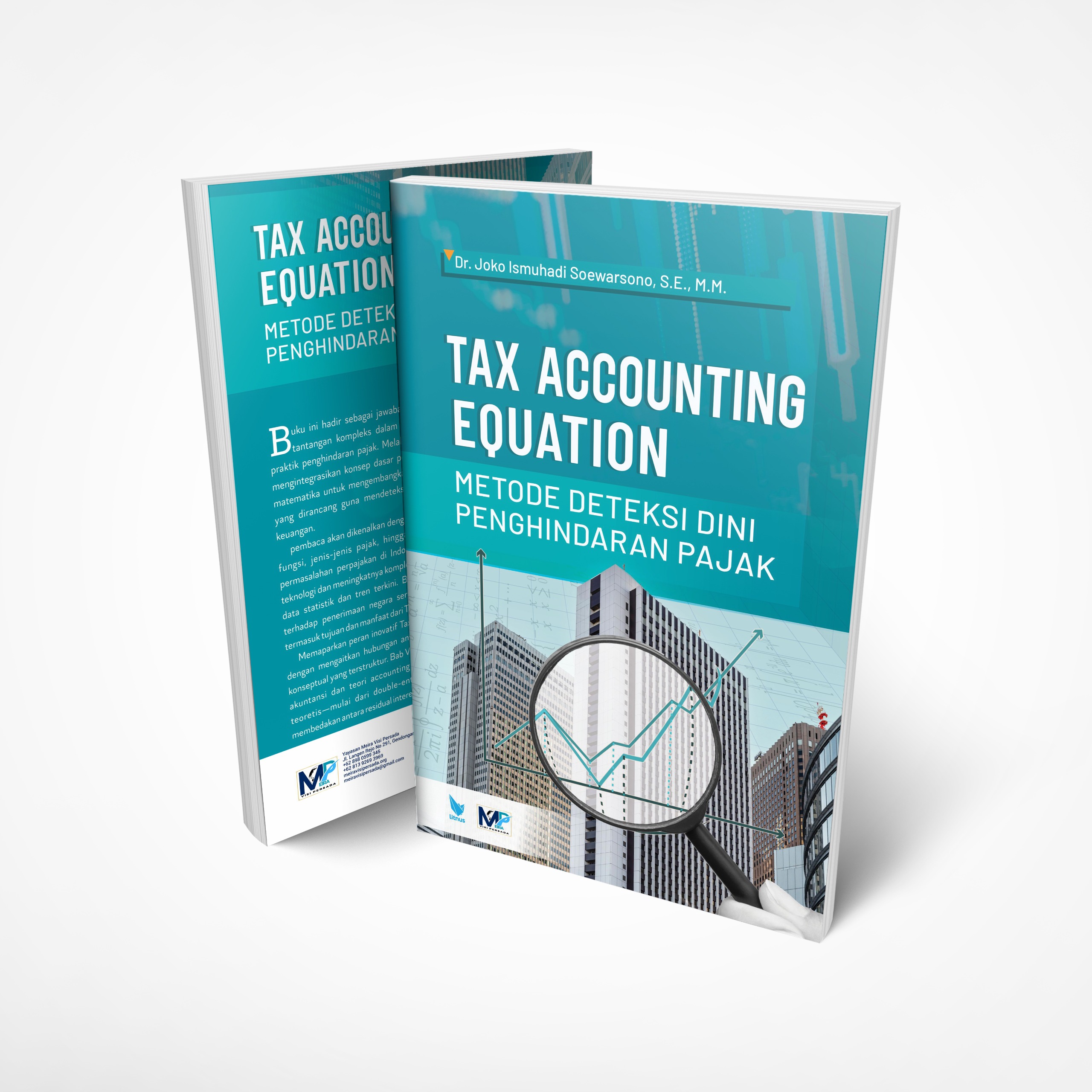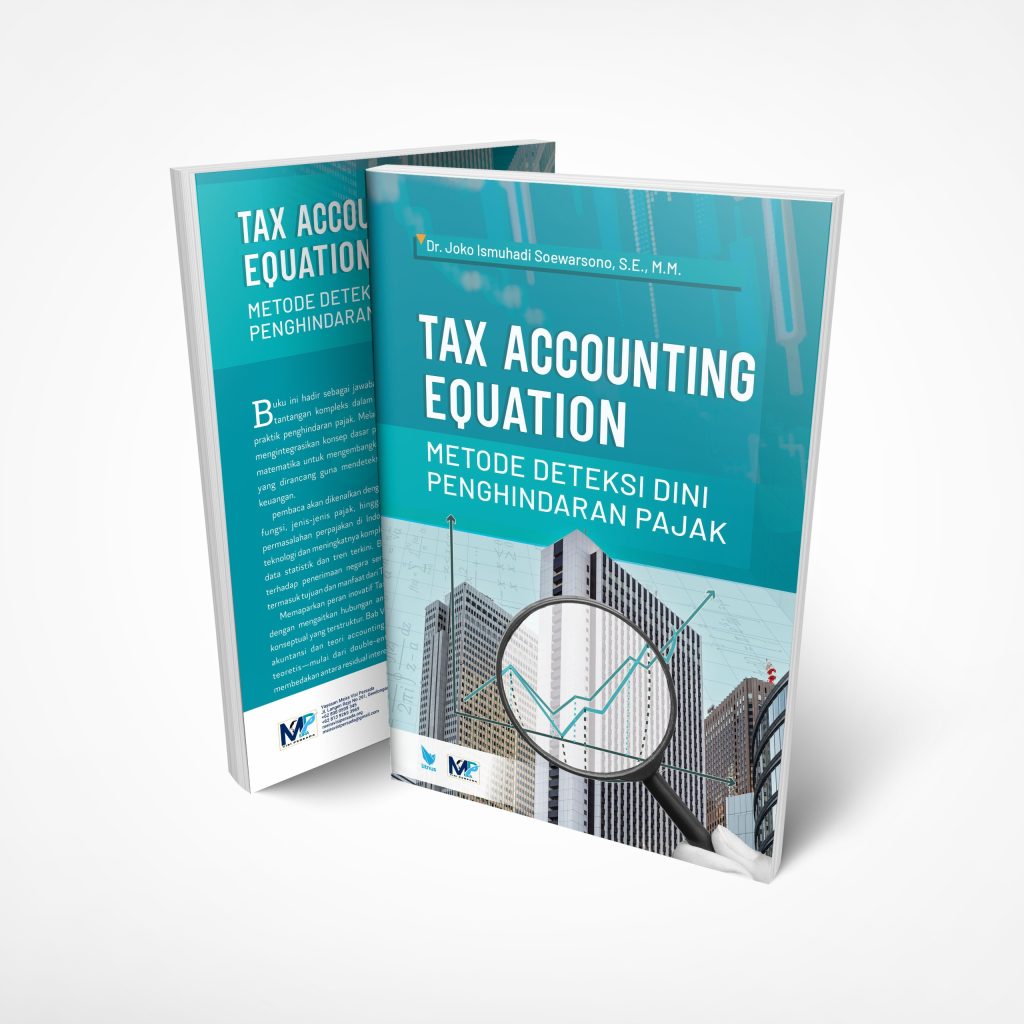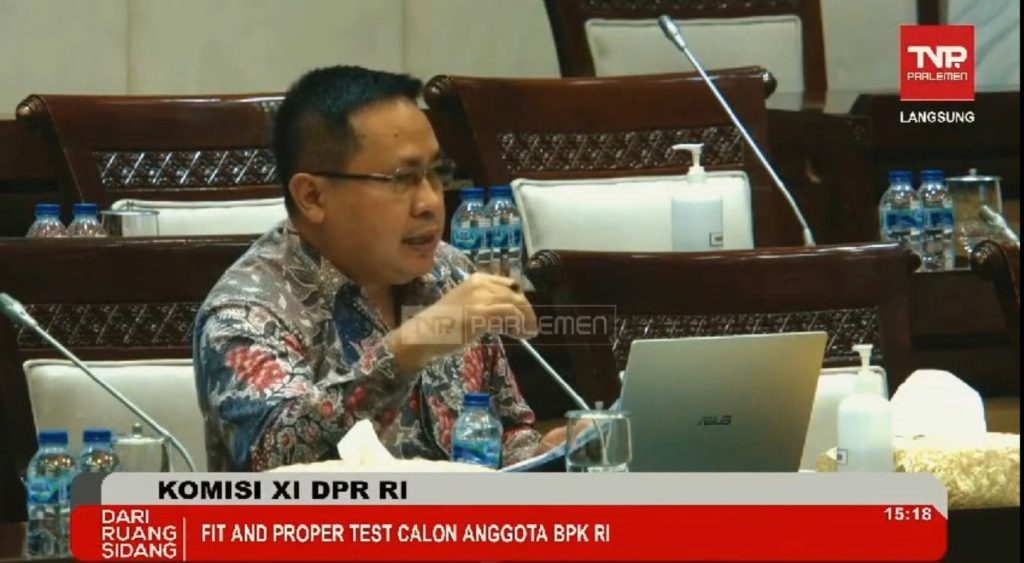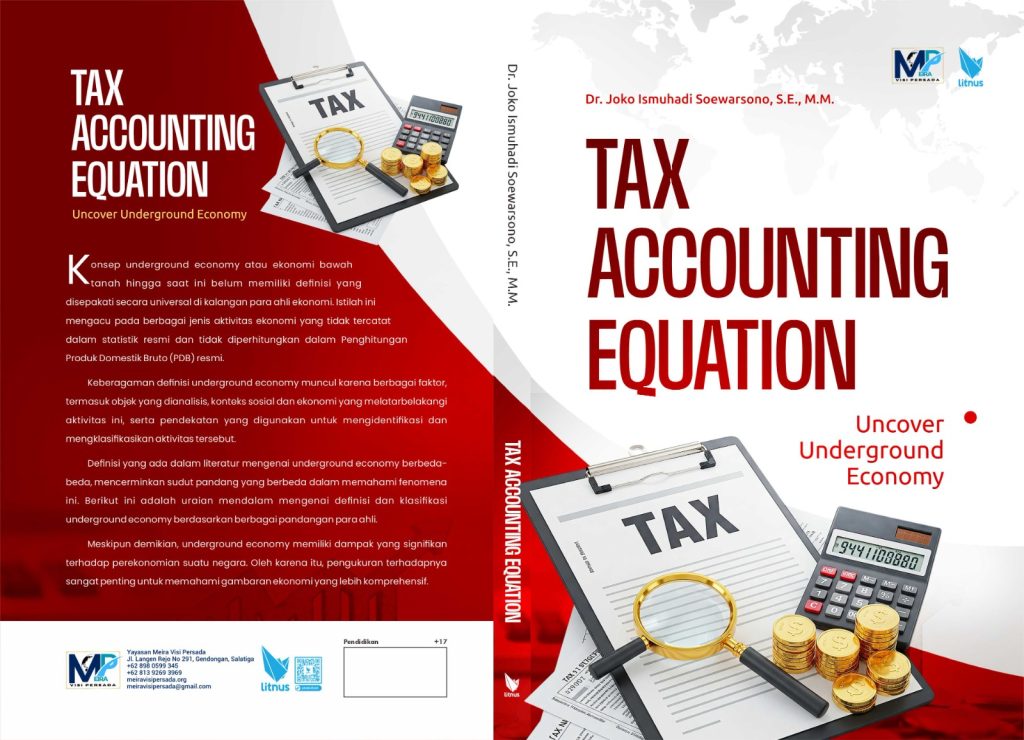
The Integrated CTAS-TAE-SAMS Framework: A Proactive Paradigm for Enhancing National Tax Ratios
- Ekonomi
Sunday, 01 June 2025 03:48 WIB

Jakarta, fiskusnews.com:
Executive Summary
The proposed integration of Dr. Joko Ismuhadi’s Tax Accounting Equation (TAE) and a Self-Assessment Monitoring System (SAMS) within a modernized Core Tax Administration System (CTAS) represents a transformative approach to tax administration. This framework signifies a fundamental shift from a reactive, audit-heavy enforcement model to a proactive, data-driven compliance and early intervention system. The system’s core components include a robust CTAS as the technological backbone, the forensic capabilities of Dr. Ismuhadi’s TAE for identifying financial irregularities, and SAMS as the intelligent engine for real-time monitoring and analysis.
The anticipated benefits of this integration are substantial and multifaceted. It promises significantly enhanced detection capabilities for hidden income and fraudulent activities, fostering voluntary compliance through mechanisms like the “Appeal Tax Deposit” (Himbauan Setoran Pajak). Furthermore, it is projected to yield marked improvements in administrative efficiency by reducing the reliance on costly audits, accelerate tax revenue collection, and directly contribute to a substantial increase in the national tax ratio while narrowing the persistent tax gap. This initiative aligns closely with leading global practices in digital tax administration, positioning it as a critical step towards establishing a more equitable, predictive, and transparent tax system.
1. Introduction: The Imperative for Modernizing Tax Administration
The global fiscal landscape is increasingly challenged by persistent tax avoidance and evasion, which significantly impact national revenue streams, particularly in emerging economies. Sophisticated strategies employed by multinational corporations and high-net-worth individuals necessitate the development and implementation of innovative tools for detection and prevention. This challenge is encapsulated in the concept of the “tax gap”—the difference between taxes legally owed and taxes actually collected. Developing countries, for instance, contend with an average tax gap estimated at 9% of their Gross Domestic Product (GDP). Globally, non-compliance rates remain a concern, averaging 15% in developed economies and exceeding 30% in developing nations. Strategies like Base Erosion and Profit Shifting (BEPS) alone account for an estimated USD 100-240 billion in lost revenue annually worldwide.
Traditional tax enforcement models, heavily reliant on reactive, post-filing audits, have proven insufficient in combating these complex evasion schemes. Such conventional approaches are inherently costly, time-consuming, and often act only after non-compliance has already occurred. Historically, manual data processing systems were prone to errors and inefficiencies, making the detection of fraud particularly difficult. This reliance on reactive measures contributes to a significant gap, sometimes as high as 25%, between reported and actual taxable income.
The substantial global tax gap, acutely observed in economies like Indonesia where the tax ratio in 2021 stood at a very low 10.9% compared to the Asia Pacific average of 19.8% and OECD member countries’ 23.2% , is not merely a statistical anomaly. It represents a critical economic and social problem that underscores the urgent need for comprehensive digital transformation in tax administration. This quantifiable fiscal challenge directly fuels the imperative for governments to invest in advanced tax technologies. The proposed CTAS-TAE-SAMS system is not merely an efficiency upgrade; it is a strategic response to a fundamental economic vulnerability, aiming to bolster national revenue mobilization.
In response to these pervasive challenges, the integration of a Core Tax Administration System (CTAS), Dr. Joko Ismuhadi’s Tax Accounting Equation (TAE), and a Self-Assessment Monitoring System (SAMS) emerges as an innovative and strategic solution. This synergy is designed to fundamentally shift tax enforcement from its traditional reactive, audit-heavy model to a preventive and corrective compliance framework. This transformation aims to create a smarter, more responsive, and data-driven tax administration system , aligning with leading global practices in digital tax administration. This initiative promises enhanced taxpayer compliance, marked improvements in administrative efficiency, accelerated tax revenue collection, and a direct increase in the national tax ratio.
The shift from reactive, audit-heavy enforcement to a preventive and corrective compliance model is a fundamental strategic reorientation, driven by the inherent inefficiencies and limitations of traditional methods. This is not just an operational adjustment; it is a strategic pivot. Traditional methods are demonstrably resource-intensive and often foster adversarial relationships between tax authorities and taxpayers. A proactive model, enabled by real-time data and artificial intelligence, aims to identify issues before they escalate into full-blown audits, offering taxpayers a crucial opportunity to self-correct. This approach fosters voluntary compliance and reduces the need for costly enforcement actions, thereby optimizing resource allocation and potentially improving taxpayer trust. This strategic reorientation implies a move towards a more collaborative, or at least less confrontational, compliance environment, where the tax authority acts more as a vigilant monitor and guide rather than solely a punitive enforcer. This has profound implications for public perception of the tax authority and the overall tax culture.
2. Core Tax Administration System (CTAS): The Foundational Digital Infrastructure
The Core Tax Administration System (CTAS) serves as the indispensable technological backbone for modern tax administration. It is defined as a modernized, integrated system designed to automate and digitalize all core tax administration processes. In Indonesia, CTAS represents a bold reform program encompassing significant transformations in structures, business processes, and IT systems. However, the ambitious nature of this launch has also raised serious concerns, underscoring the complexity and potential challenges inherent in such large-scale systemic transformations. Globally, tax administrations are actively adapting their operating models, driven by the pervasive digitalization of the wider economy, rapid technological advancements, and external factors such as the COVID-19 pandemic.
CTAS is equipped with a comprehensive suite of functionalities crucial for efficient tax management. These include streamlined taxpayer registration, efficient handling of tax return (SPT) filing, robust tax payment processing, continuous compliance tracking, and integrated audit management. A critical feature of CTAS is its capacity to integrate disparate tax data sources into a cohesive system, providing a unified view of taxpayers. This extensive data integration capability is foundational, as it enables the advanced analytical functions of subsequent systems like SAMS and TAE. The broader digital transformation in tax administration involves converting manual processes into digital ones, exemplified by the widespread implementation of mandatory electronic invoicing and pre-filled tax returns. This shift is evident in the significant global increases in e-filing rates, which have risen by 17 to 23 percentage points across the three main tax types since 2014, and e-payment rates, which have increased by approximately 10 percentage points since 2018, now standing at about 90%. Further digital solutions implemented globally include taxpayer view history, self-correction features for account information, digital notifications, expanded payment options, secure document exchange, and digital signatures.
Beyond its operational functions, CTAS serves as a pivotal platform for the broader digital transformation of tax administration. It is meticulously designed to enhance efficiency, transparency, and taxpayer compliance by simplifying processes and ensuring data accessibility and reliability. Governments worldwide recognize digital technologies as critical for improving various financial services, including revenue collection, audits, and cash management. The acceleration of digital solutions, partly spurred by events like the COVID-19 pandemic, has led to significant advancements such as virtual audits, electronic casefiles, and the widespread digitization of paper records. This strategic prioritization of automation, digitalization, and electronic services now spans all functional areas of tax administration, including the migration of data to cloud environments and the establishment of digital service offices.
The successful implementation of CTAS, particularly in the Indonesian context, is intrinsically linked to the broader institutional reform of the State Revenue Authority, aiming for greater autonomy. This autonomy, supported by a robust CTAS, can significantly enhance perceptions of fairness and competence among taxpayers, thereby positively impacting the credibility of the tax authority. A modern, integrated system like CTAS provides the technical infrastructure that supports and justifies greater operational autonomy for the tax authority. By automating processes, integrating data, and reducing human error or discretion, CTAS can make tax administration more transparent and efficient. This increased efficiency and transparency, coupled with enhanced autonomy in defining goals, organizational structure, budget, and human resources , directly contributes to building taxpayer trust and improving the tax authority’s credibility, which is paramount for fostering voluntary compliance. The concerns surrounding CTAS’s launch may indeed stem from the recognition that this broader institutional reform is essential to fully realize its potential.
Furthermore, CTAS is not merely an operational system for processing tax returns and payments; its most critical, albeit often overlooked, role is its function as a comprehensive data integration hub. This capability transforms it from a transactional system into the indispensable foundation for advanced analytics and proactive compliance tools like SAMS and TAE. While the operational functions of CTAS (e.g., filing, payments) are visible and important for basic administration, the data integration aspect is the silent enabler of the entire proactive compliance model. Without CTAS effectively unifying disparate data sources—both internal and external—SAMS and TAE would lack the comprehensive, real-time, and consistent data necessary for their advanced analytical functions. This implies that CTAS’s success is not solely about smooth processing; it is fundamentally about its ability to create a “single source of truth” for taxpayer data, transforming raw information into actionable intelligence. This elevates CTAS from a mere administrative tool to a strategic intelligence platform.
3. The Tax Accounting Equation (TAE): A Novel Forensic Tool for Tax Analysis
Dr. Joko Ismuhadi, an Indonesian tax specialist and academic, has made a unique contribution by bridging the realms of tax practice and academic innovation. His distinguished career combines extensive practical experience as a tax auditor with rigorous academic pursuits, including doctoral research in both tax accounting and tax law. This dual expertise positions him as a highly credible voice in proposing novel solutions to the complex issue of tax avoidance. A cornerstone of Dr. Ismuhadi’s contribution is the formulation of the Tax Accounting Equation (TAE), an innovative mathematical model specifically designed for the analysis of financial statements from a tax perspective. He has also developed the Mathematical Accounting Equation (MAE) to address specific scenarios. His work extends beyond these equations, encompassing scholarly contributions on tax manipulation, money laundering, and the critical need for robust asset forfeiture laws.
The theoretical underpinning of TAE stems from the fundamental accounting equation: Assets = Liabilities + Equity. This foundational equation signifies that the total value of an entity’s assets is always balanced by the combined value of its debts and the claims of its owners. It forms the bedrock of the double-entry bookkeeping system, ensuring equilibrium in financial transactions. However, the general nature of this basic accounting equation may not be sufficiently equipped to uncover the often intricate and concealed methods employed in sophisticated tax evasion and the disguising of economic activities. In response to these limitations, Dr. Ismuhadi formulated the TAE (and MAE), specifically tailored for tax analysis, particularly within the Indonesian context.
The TAE is presented in two interrelated formulations, each offering a targeted lens for identifying potential tax irregularities:
- Revenue – Expenses = Assets – Liabilities: This formulation establishes a direct link between a company’s profitability, as reflected in its income statement (Revenue minus Expenses), and its net worth, as represented in its balance sheet (Assets minus Liabilities).
- Revenue = Expenses + Assets – Liabilities: This alternative perspective emphasizes that a company’s income should be sufficient to cover its operating costs and contribute to its overall net asset value. It also highlights an inverse relationship between Revenue and Liabilities.
These formulations represent a strategic rearrangement of the basic accounting equation, with a deliberate emphasis on revenue as a crucial indicator of a company’s economic activity and its consequent tax obligations. By mathematically linking revenue, expenses, assets, and liabilities, TAE provides a rigorous framework for quantitatively assessing financial statements. Significant deviations from these anticipated relationships then serve as clear indicators of potential tax avoidance or even fraudulent activities.
The primary objective of TAE is the early detection of potential tax avoidance and/or embezzlement, specifically within the Indonesian context. It is proposed as a valuable forensic tool for Indonesian tax authorities, aimed at enhancing tax enforcement capabilities and uncovering hidden economic activity that often evades taxation. TAE serves as a mechanism for the early identification of Underground Economic Activity (UEA), which frequently goes undetected by conventional tax assessment methods. Addressing UEA is a significant challenge in Indonesia, and the application of TAE could substantially contribute to expanding the tax base. By focusing on the critical interplay between profitability and net worth, TAE offers a targeted approach for detecting discrepancies in financial reporting that might indicate tax avoidance.
Dr. Ismuhadi’s TAE transcends a mere academic exercise; it is a practical application of accounting principles specifically re-engineered for the forensic detection of tax evasion. This signifies a crucial evolution in tax enforcement methodologies, moving beyond traditional qualitative assessments to a quantitative, predictive approach. The core accounting equation (Assets = Liabilities + Equity) is foundational for financial reporting, but its primary purpose is to illustrate financial position, not necessarily to flag tax manipulation. Dr. Ismuhadi’s innovation lies in rearranging and re-emphasizing components (Revenue, Expenses, Assets, Liabilities) to create specific relationships that, when violated, directly point to potential tax irregularities. This represents a shift from descriptive accounting to prescriptive or diagnostic tax analysis. It transforms accounting from a record-keeping function into a powerful enforcement intelligence tool, by actively predicting and identifying where numbers should be if compliance is maintained.
The repeated emphasis on TAE’s capacity for “early detection” is not just an operational benefit but a strategic imperative for revenue mobilization, particularly in economies with significant informal sectors. Early detection enables proactive intervention, which is far more efficient and less resource-intensive than post-facto audits. In an emerging economy like Indonesia, where the informal sector (UEA) is a major source of untaxed activity , traditional audit methods are often too slow and costly to effectively address widespread non-compliance. Early detection via TAE, integrated into SAMS and CTAS, allows the tax authority to issue “Appeal Tax Deposits” (Himbauan Setoran Pajak). This proactive approach encourages voluntary compliance before a full audit is necessary, significantly reducing the administrative burden and costs associated with enforcement. This directly translates into more efficient revenue collection and a reduction in the tax gap, as resources can be reallocated from extensive audits to more targeted interventions or other strategic functions.
Table 1: Comparison of Basic Accounting Equation vs. Tax Accounting Equation (TAE)
| Aspect | Basic Accounting Equation | Tax Accounting Equation (TAE) | Mathematical Accounting Equation (MAE) |
|---|---|---|---|
| Equation | Assets = Liabilities + Equity | Revenue – Expenses = Assets – Liabilities; Revenue = Expenses + Assets – Liabilities | Assets + Dividen + Beban = Kewajiban + Ekuitas + Pendapatan |
| Emphasis/Focus | Financial Position | Profitability and its relation to Net Worth, Revenue as key indicator | Specific scenarios for zero/negative taxable income |
| Primary Use | General financial reporting, balance sheet basis | Early detection of tax irregularities, tax avoidance, embezzlement, Underground Economic Activity (UEA) | Early detection of tax irregularities, tax avoidance, embezzlement, UEA |
| Underlying Principle | Balance between resources and financing sources | Expected equilibrium between financial reporting components and tax obligations | Expected equilibrium between financial reporting components and tax obligations |
| Applicability | General | Specifically tailored for Indonesian tax analysis | Specifically tailored for Indonesian tax analysis |
4. Self-Assessment Monitoring System (SAMS): Enabling Proactive Compliance
The Self-Assessment Monitoring System (SAMS) is specifically designed to oversee and analyze taxpayers’ self-declared tax obligations. It embodies a structured approach for organizations to evaluate their own processes and controls, thereby identifying areas for improvement and potential risks. While the core principles of SAMS—self-evaluation, proactive risk identification, and continuous improvement—were initially applied in domains such as IT and cybersecurity, they hold significant value for modern tax management. In the context of tax compliance, SAMS functions as a proactive mechanism to enhance self-awareness regarding tax obligations, foster accountability within relevant teams, and facilitate the early detection of potential tax-related issues. An effective SAMS framework necessitates clearly defined objectives and scope, along with well-established assessment criteria and metrics to evaluate compliance and identify deviations.
SAMS operates through a series of critical functionalities, including real-time data capture, automated monitoring, and extensive cross-referencing with external data sources. As taxpayers submit their tax returns (SPT) and other financial data through the CTAS, SAMS continuously captures and processes this information in real-time. It leverages advanced algorithms, often incorporating Artificial Intelligence (AI) and Machine Learning (ML), to monitor declared data against various benchmarks and historical patterns. A crucial aspect of SAMS’s effectiveness is its ability to cross-reference taxpayer information with a wide array of external data sources, such as bank records, property ownership, customs data, business permits, e-commerce transactions, and third-party reporting. This extensive cross-referencing significantly enhances data validity and aids in uncovering inconsistencies. Globally, data science and analytical tools are widely employed by tax administrations, with approximately 95% reporting their use (a 20% increase since 2018) to manipulate both third-party and internal electronic data for compliance work.
The integration of AI and Machine Learning within SAMS enables advanced anomaly detection. These algorithms are capable of processing vast amounts of tax-related data to identify patterns in tax compliance and detect anomalies indicative of tax evasion. They can rapidly analyze data to pinpoint discrepancies or potential areas of concern, substantially reducing the time and resources required for manual inspections. Supervised machine learning techniques, such as Gradient Boosting algorithms, can be trained on historical cases of tax evasion to identify taxpayer attributes correlated with a high probability of fraud. Conversely, unsupervised techniques, like k-means clustering, can detect hidden patterns of behavior within taxpayer data without relying on pre-labeled data, thereby signaling anomalous activities. AI-powered risk assessment tools have demonstrated significant efficiency gains, reducing manual audit durations by 50%, from an average of 30 days to 15 days. The adoption of AI for risk assessment and fraud detection is either fully implemented or in progress in about half of tax administrations globally.
The effectiveness of SAMS in increasing the tax ratio extends beyond its technical ability to detect anomalies; it fundamentally alters taxpayer behavior by increasing the perception of being caught, thereby fostering a stronger culture of voluntary compliance. This represents a key behavioral principle. It is not merely the actual detection rate, but the perceived likelihood of detection that drives compliance. SAMS, with its real-time, cross-referenced, and AI-powered monitoring, creates an omnipresent “digital eye” that taxpayers are acutely aware of. This constant vigilance, even if not every minor discrepancy leads to an immediate audit, psychologically nudges taxpayers towards greater accuracy and honesty in their self-assessments. It transforms the compliance environment from one where evasion might be perceived as a low-risk gamble to one where it carries a high and immediate risk of detection and subsequent intervention, such as an “Appeal Tax Deposit” (Himbauan Setoran Pajak).
While SAMS leverages advanced AI and ML, its actual effectiveness is critically dependent on the underlying quality, standardization, and real-time accessibility of data. Without robust data governance, SAMS risks generating a high rate of false positives or, more critically, missing genuine discrepancies. SAMS, as an analytical engine, is only as effective as the data it consumes. The challenges identified in Indonesia regarding data architecture and quality are not minor technical glitches but fundamental impediments. Companies often face significant challenges with growing volumes of tax data, including segregated views, limited trust in enterprise data sources, and an inability to reconcile master data gaps prior to tax filings. Governments also grapple with the rapid growth in data volume, much of which is trapped in spreadsheets or other applications that are not easily accessible or integrated. Indonesia’s experience further highlights challenges with different data architectures for various tax types, complicating analysis. Inaccurate, fragmented, or non-standardized data will severely undermine the analytical power of TAE and the predictive capabilities of SAMS, potentially leading to a high rate of incorrectly identified discrepancies or, more critically, undetected non-compliance. Therefore, prior to or concurrently with SAMS implementation, significant investment and strategic focus must be placed on data governance, data standardization, and establishing interoperability across disparate systems. Failure to do so risks not only operational inefficiency but also a loss of trust in the system if it frequently flags compliant taxpayers or misses significant evasion, ultimately undermining its very purpose and the desired deterrence effect.
5. The Integrated System in Action: CTAS-TAE-SAMS Synergy
The core innovation of this transformative approach lies in the dynamic integration of TAE and SAMS capabilities directly within the Core Tax Administration System (CTAS), thereby transforming it into an intelligent monitoring and intervention system. This synergy is designed to create a smarter and more responsive tax administration system. As financial data, including income statements and balance sheets, is submitted by taxpayers via CTAS, the SAMS automatically applies the Tax Accounting Equation. SAMS accesses all taxpayer accounting data relevant to the TAE, which can include information directly from the taxpayer’s accounting system (if integrated), financial statements, or other necessary data for forming the tax accounting equation. This seamless integration allows taxpayer accounting data to be automatically analyzed to detect anomalies indicative of potential tax under-reporting.
The system performs continuous data consistency checks, ensuring that the relationships defined by the TAE hold true for each taxpayer’s reported financial figures. For instance, if a company reports minimal revenue but shows a significant, unexplained increase in assets, the TAE will immediately flag this inconsistency. Any material deviation from the expected relationships derived from the TAE is promptly highlighted by the SAMS, indicating potential discrepancies, inconsistencies, or anomalies in the reported financial data. The system employs a sophisticated risk-based assessment approach, ensuring that not every minor discrepancy triggers an immediate action. Instead, it prioritizes taxpayers with high-risk profiles based on the severity and nature of the anomalies detected. AI algorithms, for example, can categorize taxpayers as Low Risk, Moderate Risk, or High Risk, allowing for targeted scrutiny.
A crucial proactive compliance management mechanism within this integrated system is the “Appeal Tax Deposit” (Himbauan Setoran Pajak). When the SAMS, powered by the TAE and cross-referenced external data, identifies a high discrepancy or inconsistency suggesting under-reporting of income, overstating of expenses, or other forms of tax manipulation, it automatically “flags” the taxpayer. For these flagged high-risk taxpayers, the CTAS, working in conjunction with SAMS, automatically generates and issues an “Appeal Tax Deposit” notice. This notice is formal yet non-punitive, informing the taxpayer about the identified discrepancies and suggesting that their tax declaration might be incomplete or incorrect. It prompts the taxpayer to voluntarily review their records, correct their tax return, and make any necessary additional tax payments. This mechanism provides taxpayers with a vital opportunity to rectify their errors or omissions before a formal audit or legal enforcement action is initiated. It functions as a preventive, pre-enforcement step, encouraging self-correction and allowing taxpayers to come into compliance without incurring penalties that would typically arise from an audit finding.
The “Appeal Tax Deposit” (Himbauan Setoran Pajak) is not merely an automated notification; it is a sophisticated behavioral intervention designed to leverage the perceived risk of audit while simultaneously providing an “off-ramp” for voluntary compliance. This mechanism is crucial for the system’s shift to proactive compliance. By issuing a non-punitive notice based on intelligent detection, the tax authority creates a “nudge.” It signals that the taxpayer’s activities are being monitored and that discrepancies are detected, thereby increasing the perceived cost of non-compliance and reinforcing the “deterrence effect.” However, by offering a voluntary correction pathway without immediate penalties, it reduces the friction and psychological barrier to compliance, making self-correction a more appealing option than facing a full audit. This approach balances enforcement with facilitation, fostering a more positive compliance culture while still ensuring efficient revenue collection.
While AI and Machine Learning significantly enhance detection capabilities, their integration into the CTAS-TAE-SAMS system introduces the critical challenge of algorithmic transparency and explainability, particularly when automated decisions, such as issuing a himbauan, are made. This poses a significant legal and ethical risk if not properly addressed. The power of AI to detect complex patterns is undeniable. However, if the reasoning behind a “flag” or a himbauan is opaque due to “black box” AI systems, taxpayers may perceive the system as unfair or arbitrary. This directly contradicts the goal of fostering trust and voluntary compliance. Furthermore, in a liberal society, state interference, even a non-punitive notice, requires a legal basis and clear rules on data processing and human intervention. The lack of explainability creates legal accountability issues and makes it difficult for taxpayers to appeal or understand the basis of the discrepancy. Therefore, for the CTAS-TAE-SAMS system to be truly effective and equitable, the development of explainable AI (XAI) and robust oversight mechanisms for AI-driven decisions are not merely desirable features but foundational requirements to maintain public trust and legal defensibility.
Table 2: Key Features of CTAS, SAMS, and TAE in Integration
| Component | Primary Role | Key Functionalities | Technologies Used | Impact on Compliance Model | Interdependency |
|---|---|---|---|---|---|
| CTAS | Foundational digital backbone, data integration | Taxpayer registration, filing, payments, audit management | Automation, digitalization, integrated databases, cloud computing, APIs | Enables shift from reactive to proactive, enhances efficiency | Provides unified data for SAMS/TAE |
| SAMS | Proactive monitoring, anomaly detection, data cross-referencing | Real-time data capture, automated monitoring, risk-based assessment | AI, Machine Learning, advanced algorithms, data science, predictive analytics | Fosters voluntary compliance, pre-enforcement | Leverages CTAS data, applies TAE |
| TAE | Forensic mathematical model, consistency checks | Automated application to financial data, flagging deviations | Mathematical formulations, forensic accounting principles | Targets hidden economic activity, identifies tax manipulation | Utilized by SAMS to analyze CTAS data |
6. Pathways to an Increased Tax Ratio and Reduced Tax Gap
The integrated CTAS-TAE-SAMS system contributes to an increased national tax ratio and a narrower tax gap through several interconnected mechanisms.
Enhanced Detection Capabilities and Recovery of Undeclared Liabilities: The sophisticated analytical power of TAE within SAMS, combined with the vast data integration capabilities of CTAS, significantly improves the ability of tax authorities to detect hidden income, unreported transactions, and fraudulent activities that might otherwise go unnoticed. AI-driven fraud detection has demonstrated a remarkable increase in effectiveness, rising from identifying 14.7% of evasion cases in 2021 to 55.0% in 2024. Similarly, machine learning models have enhanced overall tax evasion detection rates from 20% in 2020 to 55% in 2024. This heightened detection capacity directly aids in identifying and recovering undeclared tax liabilities through both voluntary compliance and targeted enforcement, thereby narrowing the “tax gap”—the difference between taxes legally owed and taxes actually collected.
Shift to Proactive Compliance: Reducing Audit Reliance and Administrative Burden: By issuing the “Appeal Tax Deposit” (Himbauan Setoran Pajak) based on automated flagging, the system proactively encourages taxpayers to voluntarily pay outstanding taxes. This preventive approach substantially reduces the need for costly and time-consuming audits, freeing up valuable resources for tax administrations. For instance, AI-assisted audits have been shown to reduce audit duration by 50%, from an average of 30 days to just 15 days. Globally, AI-driven solutions contributed to a 15% increase in compliance rates in 2023, resulting in an approximate reduction of $300 billion in tax evasion losses.
Deterrence Effect on Non-Compliance: A significant contribution of this integrated system is its powerful deterrence effect. Taxpayers become acutely aware that their financial data is continuously analyzed by an intelligent system. This knowledge creates a strong disincentive against non-compliance, as the likelihood of being caught increases significantly. This increased perceived detection risk actively promotes voluntary compliance across the taxpayer base. The deterrence effect of the integrated system is not just a direct consequence but a critical multiplier for increasing the tax ratio, as it influences a broader base of taxpayers to comply, even those not directly flagged. The system’s ability to detect and flag is one thing, but its reputation for doing so is another. As awareness of the CTAS-TAE-SAMS system’s capabilities grows among the taxpayer base, it creates a systemic disincentive for non-compliance. This means that even taxpayers who haven’t received a himbauan may choose to be more compliant, fearing detection. This broad behavioral shift, driven by the perceived omnipresence of the intelligent system, contributes to tax ratio increases beyond just the direct recovery of flagged discrepancies. It reduces the “tax gap” not only by catching evaders but by preventing evasion in the first place across a wider population.
Improved Efficiency and Resource Allocation within Tax Administration: The automation of data analysis and discrepancy flagging significantly reduces manual effort for tax officers, enabling them to concentrate on more complex cases and high-value audits. The integration of AI improves overall efficiency by automating complex tax return processes, detecting anomalies, and minimizing human error. Countries that have invested heavily in AI have reported an increase in revenue collection efficiency by as much as 20%. Furthermore, Robotic Process Automation (RPA) automates repetitive tasks, thereby freeing up resources for more strategic functions within the tax administration. The efficiency gains from automation and proactive compliance (reduced audit duration, less manual effort) are not merely cost savings but represent a strategic opportunity for tax administrations to reallocate highly skilled human resources towards more complex, high-value, and strategic tasks. Beyond simple cost reduction, this frees up human capital—experienced tax officers and auditors—from repetitive, low-value tasks. These professionals can then be deployed to tackle sophisticated tax avoidance schemes (such as those addressed by BEPS initiatives ), engage in complex international tax cooperation, develop new policy, or provide more personalized taxpayer services. This strategic reallocation enhances the overall capacity and sophistication of the tax administration, making it more agile and effective in responding to evolving tax challenges. It shifts the human role from data processors to strategic analysts and complex problem-solvers.
Contribution to a Fairer and More Equitable Tax System: A tax system that more effectively detects and addresses non-compliance contributes significantly to a fairer tax environment. In such a system, compliant taxpayers are not unfairly burdened by those who evade their obligations. By identifying and recovering undeclared tax liabilities, the system helps ensure that profits are taxed where economic activity and value creation genuinely take place, aligning with fundamental principles of fairness and equity.
Table 3: Mechanisms for Increasing Tax Ratio through CTAS-TAE-SAMS
| Mechanism | How CTAS-TAE-SAMS Contributes | Direct Impact on Tax Ratio |
|---|---|---|
| Enhanced Detection | Sophisticated analytics, cross-referencing external data, AI/ML-driven anomaly detection | Uncovers hidden revenue, increases collections from previously untaxed activities |
| Proactive Compliance | Automated flagging, Himbauan Setoran Pajak, opportunity for voluntary correction | Accelerates revenue collection, reduces enforcement costs by encouraging self-correction |
| Deterrence Effect | Increased perceived risk of being caught due to continuous intelligent monitoring | Encourages broader voluntary compliance across the taxpayer base, preventing evasion |
| Improved Administrative Efficiency | Automation of data analysis, discrepancy flagging, reduced manual audits, strategic resource reallocation | Optimizes resource use, boosts overall collection capacity and effectiveness |
| Reduced Tax Gap | Identification and recovery of undeclared liabilities, prevention of new evasion | Closes the difference between taxes legally owed and taxes actually collected |
| Fairer Tax System | Equitable enforcement, ensuring all taxpayers meet obligations, level playing field for compliant entities | Builds public trust, fosters a positive compliance culture, reduces burden on compliant taxpayers |
7. Global Context: Digital Transformation in Tax Administrations
The CTAS-TAE-SAMS initiative in Indonesia is not an isolated development but rather aligns with a broader global trend towards the digital transformation of tax administrations. The international landscape of tax compliance is increasingly characterized by complex regulations and a widespread adoption of self-assessment systems, which place significant responsibility on taxpayers for accurate reporting and remittance. Tax administrations worldwide are actively adapting their operating models in response to pervasive digitalization, rapid technological advancements, and various external factors. There is a clear and growing trend towards more proactive approaches to influencing taxpayer compliance, moving away from purely reactive enforcement.
Artificial Intelligence (AI), Machine Learning (ML), and data analytics are at the forefront of this global transformation. AI is rapidly expanding across various tax administration functions, driven by the immense data capacity now available and the significant increase in computational power, including the emergence of generative AI. Key trends in AI adoption include:
- Over 60% of tax administrations (TAs) now offer virtual or digital assistants to help taxpayers with queries and support self-service, a nearly 30 percentage point increase since 2018.
- Approximately 95% of TAs report using data science and analytical tools to manipulate third-party electronic data (including from other TAs) and internally generated data for compliance work, representing an increase of over 20% since 2018.
- 54.4% of TAs are utilizing AI and ML in their tax management, and 50% have applied Robotic Process Automation (RPA), showing increases of more than 22% from 2018 to 2021.
- Over 80% of TAs are either using or are in the implementation phase for state-of-the-art techniques designed to reduce the need for human intervention.
- The use of AI and ML for risk assessment and fraud detection is either already implemented or in progress in about half of TAs globally.
The benefits of AI for TAs are extensive, encompassing improved information management, enhanced data behavior analysis, optimized citizen services, streamlined processes, reduced costs, and the detection of previously hidden correlations and suspicious activities.
Numerous jurisdictions offer compelling case studies and examples of integrated tax systems and proactive compliance. Countries such as Brazil, Chile, and Mexico have spearheaded the implementation of advanced digital platforms for tax management, enabling the automation of key processes, the integration of diverse databases, and the generation of predictive models for tax fraud detection. Digitalization milestones include the widespread adoption of electronic invoicing (a global benchmark in Latin America and the Caribbean), electronic taxpayer registries, electronic declarations, and electronic payments. Beyond mere digitalization, true digital transformation reconfigures tax administration operations with a taxpayer-centric approach, leveraging advanced strategies such as data science, analytical tools, Application Programming Interfaces (APIs), cloud computing, AI, blockchain, RPA, and digital identification systems. In the United States, the IRS has implemented various digital solutions, including online taxpayer accounts for viewing tax history, updating account information, receiving digital notifications, expanding payment options, and secure document exchange. They have also accelerated digital mailroom projects and prioritized automation and e-services across all functional areas. AI-powered risk assessment tools, such as the IRS model, categorize taxpayers into risk profiles (Low, Moderate, High Risk) to facilitate targeted scrutiny or the application of softer compliance strategies.
The widespread adoption of AI, ML, and data analytics across diverse jurisdictions (OECD countries, Latin America, and the United States) signifies a global convergence in tax administration strategy. This convergence is driven by common challenges, such as sophisticated tax evasion, and the opportunities presented by digital technologies. This positions Indonesia’s CTAS-TAE-SAMS initiative as part of a larger, proven global trend. This consistent global pattern is not coincidental; it indicates that tax authorities worldwide are facing similar pressures (e.g., complex evasion, digital economy challenges, the need for efficiency) and are arriving at similar technological solutions. This convergence validates the strategic direction taken by Indonesia. It suggests that the challenges and benefits observed in other jurisdictions—such as increased revenue, reduced audit times, and improved detection—are likely transferable, providing a strong argument for the system’s potential success and mitigating concerns about its novelty. It also highlights the need for international collaboration on best practices and regulatory frameworks.
Innovative tax compliance strategies are also being adopted by multinational corporations to navigate the increasingly complex global tax environment. Governments worldwide are tightening enforcement and introducing stringent digital reporting requirements, including Digital Services Taxes (DSTs), Base Erosion and Profit Shifting (BEPS) reforms, and global minimum tax rules. Innovative techniques for achieving tax efficiency include negotiating Advance Pricing Agreements (APAs) for cross-border transactions, strategically utilizing holding companies and conduit entities in favorable jurisdictions for optimized profit repatriation and double taxation mitigation, and implementing digital transformation in tax management. Multinational corporations are increasingly establishing global compliance teams, investing in smart payroll and tax technology (featuring automated rule updates, multi-currency support, and audit trails), collaborating with expert tax advisors, conducting regular internal audits, and maintaining comprehensive documentation. Technology plays a crucial role in this, with AI facilitating data validation, predictive risk alerts, and smart classification; blockchain providing secure, immutable records and smart contracts; and modern tax software offering consolidated views and real-time updates. Tax transparency initiatives like the Common Reporting Standard (CRS) and Country-by-Country Reporting (CbCR) facilitate the automatic exchange of financial information, enabling tax authorities to identify aggressive tax planning.
The increasing complexity of international tax rules (BEPS, global minimum tax, transfer pricing) and the global crackdown on offshore tax havens necessitate that multinational corporations adopt advanced digital tools and integrated systems, mirroring the digital transformation occurring within tax authorities themselves. This creates a symbiotic pressure for digital adoption on both sides. As tax authorities globally become more sophisticated in their data analysis and enforcement through digital transformation (as exemplified by CTAS-TAE-SAMS and other international examples), they are simultaneously imposing more stringent and digitally-enabled reporting requirements on multinational corporations. This creates a feedback loop: governments demand more granular digital data (e.g., electronic invoicing, CbCR), which in turn compels companies to invest in integrated tax management systems and AI to manage their compliance. The “arm’s length principle” for transfer pricing and the need for robust documentation become manageable only with advanced technology. Thus, digital transformation is no longer optional for multinational corporations but a critical prerequisite for navigating the complex global tax landscape and avoiding penalties. This interdependency implies that the success of government digital tax systems is partly contingent on the digital maturity of the taxpayer base, especially large corporations.
8. Challenges and Critical Considerations for Implementation
While the integrated CTAS-TAE-SAMS system offers transformative potential, its successful and equitable implementation necessitates careful navigation of significant challenges and critical considerations.
Data Quality, Standardization, and Interoperability Challenges: The efficacy of the TAE-SAMS integration is critically dependent on the quality, standardization, and real-time accessibility of the underlying accounting data. Companies frequently encounter difficulties with the increasing volume of tax data, including segregated views, limited trust in enterprise data sources, and an inability to reconcile master data gaps prior to tax filings. Similarly, governments grapple with the rapid growth in data volume, much of which remains trapped in spreadsheets or other applications that are not easily accessible or integrated. Indonesia’s own experience highlights specific challenges related to differing data architectures for various tax types, which can complicate comprehensive data analysis. Inaccurate, fragmented, or non-standardized data will severely undermine the analytical power of TAE and the predictive capabilities of SAMS, potentially leading to a high rate of false positives (incorrectly identified discrepancies) or, more critically, missed discrepancies (undetected non-compliance). Therefore, robust data governance and interoperability are foundational requirements, not merely desirable features.
Legal and Ethical Implications: The implementation of AI-driven tax systems introduces profound legal and ethical considerations:
- Data Privacy and Security Risks: The use of AI in tax systems necessitates access to vast amounts of personal and financial data, raising significant concerns about data privacy and security. There is an inherent risk of cyberattacks or data breaches that could expose sensitive financial details. Protecting taxpayer data is a primary ethical responsibility, demanding strict compliance with international data protection standards such as GDPR. A specific risk is data leakage, where sensitive or confidential data fed into open AI tools might be incorporated into the AI model and subsequently outputted to unauthorized external parties.
- Algorithmic Bias and Ensuring Equitable Outcomes: A critical ethical concern is the potential for AI systems to perpetuate or even amplify existing biases in tax enforcement. Since AI algorithms learn from historical data for predictions and decisions, any biases inherent in that historical data may be transferred to the AI models. This could, for instance, lead to biased audit targeting that disproportionately affects certain taxpayer groups, resulting in perceived unfair treatment and potentially discouraging compliance. Bias stemming from historical data can lead to discriminatory results for minority or marginalized sections of the taxpayer population.
- Transparency, Accountability, and the Necessity of Human Oversight: The use of “black box” AI systems, where the decision-making process is opaque, can lead to a lack of transparency, making it difficult for taxpayers to understand how decisions are reached. As AI systems assume more decision-making responsibilities, complex questions arise regarding legal accountability for erroneous tax decisions. There is a risk of inadequate protection of taxpayers’ rights and guarantees if decisions are made solely by AI without sufficient human intervention. It is crucial that human tax officials critically scrutinize AI-generated output before acting upon the results.
- Need for Robust Regulatory Frameworks: The deployment of tax administration AI must be legally framed with clear rules governing the origin of the data, the methods of data processing, the specific aim of the data processing, and the possibility of human intervention. Depending on the particular purpose of using tax administration AI, additional legal prerequisites may also be necessary. Robust regulatory frameworks are essential to foster a balanced approach to AI integration, ensuring that technological feasibility aligns with societal values.
The paradox of efficiency versus trust in AI-driven tax systems is a significant challenge. While AI promises unprecedented efficiency and accuracy, its implementation introduces a fundamental tension with taxpayer trust and acceptance, particularly concerning data privacy and algorithmic fairness. Over-reliance on “black box” AI without transparency can erode the very voluntary compliance the system aims to foster. The core objective of increasing the tax ratio relies heavily on voluntary compliance and deterrence. However, if taxpayers perceive the system as intrusive, unfair, or opaque, it can lead to distrust, resistance, and ultimately, a decrease in voluntary compliance, thereby negating the efficiency gains. This creates a critical paradox: the more powerful and automated the AI, the greater the need for robust ethical safeguards, explainability (XAI), and human oversight to maintain public trust. The challenge is not just technical implementation but socio-legal integration, ensuring that technological advancement does not come at the expense of fundamental taxpayer rights and public acceptance.
Integration Hurdles with Legacy Tax Systems: Integrating AI into existing tax infrastructure poses several practical challenges. Many tax authorities still rely on outdated legacy systems that may not be equipped to handle advanced AI applications or integrate seamlessly with modern technologies like machine learning and blockchain. Upgrading these systems to support AI-driven solutions requires significant investment in software development, hardware, and staff training. The substantial cost and inherent complexity of these upgrades can deter tax authorities from adopting AI technologies. The challenge of integrating AI with legacy tax systems is more than a technical or cost impediment; it represents a strategic bottleneck that can severely limit the pace and scope of digital transformation, potentially undermining the full benefits of advanced systems like CTAS-TAE-SAMS. This is not just about technical compatibility; it is about the fundamental architecture and data models of older systems. Legacy systems often have fragmented data, non-standardized formats, and siloed operations , which directly contradict the need for unified, real-time, high-quality data required by SAMS and TAE. Therefore, the “hurdle” is not just connecting new to old, but a complete overhaul or substantial modernization of the underlying data infrastructure. This implies that the full realization of CTAS-TAE-SAMS’s potential will be a multi-year, multi-phase endeavor, requiring sustained political will and significant budgetary allocation beyond initial implementation. It also suggests that the pace of reform might be dictated more by the ability to modernize foundational IT than by the readiness of AI algorithms themselves.
Workforce Adaptation and Training Requirements: The implementation of AI-driven tax systems necessitates significant changes in the tax workforce. Tax authorities must ensure their employees possess the necessary skills, such as data analysis, machine learning proficiency, and cybersecurity knowledge, to effectively work alongside AI tools. Comprehensive training programs are needed for employees whose roles may be impacted by automation, equipping them to take on new tasks like overseeing AI systems or focusing on more complex cases that require human judgment.
Ensuring Taxpayer Acceptance and Trust: Taxpayer perceptions regarding fairness, trust, and voluntary compliance are significantly shaped by the use of AI in tax administration. While predictive analytics and chatbot integration can improve system efficiency and foster greater trust, concerns about excessive monitoring can have adverse effects. Transparent AI operations are fundamental to underpinning taxpayer trust and cooperation in modern tax systems.
Table 4: Opportunities and Challenges of AI-Driven Tax Transformation
| Category | Aspect | Description | Mitigation/Addressing |
|---|---|---|---|
| Opportunities | Improved Efficiency and Accuracy | AI automates discrepancy identification, reducing human error and speeding up processing. | N/A |
| Reduced Administrative Burden | Automation of routine tasks lessens workload for taxpayers and authorities. | N/A | |
| Enhanced Taxpayer Engagement | AI tools (chatbots, virtual assistants) offer 24/7 support and personalized advice. | N/A | |
| Enhanced Fraud Detection | AI/ML algorithms identify patterns and anomalies indicative of tax evasion more effectively. | N/A | |
| Proactive Compliance | Early detection and nudges encourage voluntary self-correction before audits. | N/A | |
| Resource Reallocation | Frees up human resources for complex cases and strategic functions. | N/A | |
| Challenges | Data Security Risks | Access to vast personal/financial data raises privacy and security concerns. | Robust cybersecurity, GDPR compliance, secure data storage, AI auditing |
| Ethical Concerns (Algorithmic Bias, Lack of Transparency, Accountability) | AI bias from historical data can lead to unfair treatment; opaque systems hinder understanding and accountability. | Explainable AI (XAI), ethical standards, robust regulatory frameworks, periodic audits, holistic data collection, clear legal frameworks, human oversight | |
| Integration Hurdles with Legacy Systems | Outdated tax infrastructure may not support modern AI applications without significant investment. | Strategic modernization, phased replacement, public-private partnerships | |
| Workforce Adaptation | Employees need new skills (data analysis, ML, cybersecurity) to work with AI. | Comprehensive training programs, upskilling initiatives | |
| Upfront Costs | Initial investment in AI technologies can be substantial. | Public-private partnerships, international collaboration for shared burden | |
| Taxpayer Acceptance/Trust | Concerns about excessive monitoring or unfairness can erode voluntary compliance. | Transparent communication, framing system benefits, ensuring fairness and explainability |
9. Conclusion and Recommendations
The integration of Dr. Joko Ismuhadi’s Tax Accounting Equation (TAE) and a Self-Assessment Monitoring System (SAMS) within a Core Tax Administration System (CTAS) represents a profound transformation in tax administration. This sophisticated framework shifts the paradigm from a reactive, audit-centric enforcement model to a proactive, data-driven system capable of intelligently identifying and addressing non-compliance. This strategic reorientation moves beyond merely “chasing” tax evasion to actively “preventing and correcting” it. The system’s ability to boost the national tax ratio is multifaceted, stemming from enhanced detection capabilities, the promotion of proactive compliance, a strong deterrence effect on potential evaders, and significant improvements in administrative efficiency. Ultimately, this initiative marks a critical step towards establishing a tax system that is not only data-driven and predictive but also more equitable, aligning with leading global practices in digital tax administration.
For the successful implementation and sustained effectiveness of this advanced integrated tax system, the following key recommendations are put forth:
- Prioritize Data Governance and Interoperability: A foundational requirement is a substantial investment in standardizing data formats, ensuring high data quality, and building robust integration capabilities across all internal and external data sources. The efficacy of TAE and SAMS is critically dependent on the quality, standardization, and real-time accessibility of the underlying data. Without this, the system risks generating a high rate of false positives or, more critically, missing genuine discrepancies.
- Develop Robust Legal and Ethical Frameworks for AI: It is imperative to establish clear legislation and policies that govern the origin of data, processing methods, the specific purpose of data processing, and the possibility of human intervention in AI-driven decisions. Mandating Explainable AI (XAI) and periodic audits of AI models is crucial to ensure algorithmic fairness, prevent bias, and maintain transparency in decision-making. This approach directly addresses the paradox between AI efficiency and taxpayer trust.
- Ensure Human Oversight and Accountability: Clear protocols for human review and override of AI-generated flags and decisions must be implemented. Furthermore, legal accountability for AI-driven errors must be explicitly defined. This ensures that technological advancements do not come at the expense of fundamental taxpayer rights and public acceptance.
- Invest in Workforce Adaptation and Training: Comprehensive training programs are essential to upskill tax professionals in data analytics, AI literacy, and cybersecurity. This prepares them for new roles in an AI-augmented environment, where their expertise shifts from manual processing to strategic analysis and oversight.
- Strategic Modernization of Legacy Systems: A phased approach to modernizing or replacing outdated IT infrastructure is necessary to ensure seamless integration with new AI-driven components. Considering public-private partnerships can help share costs and leverage external expertise for this significant undertaking. This addresses the strategic bottleneck posed by legacy systems, which can otherwise limit the pace and scope of digital transformation.
- Foster Taxpayer Trust and Communication: Implementing transparent communication strategies about the system’s operation, its benefits, and the safeguards in place for taxpayer rights is vital. Framing the “Appeal Tax Deposit” (Himbauan Setoran Pajak) as an opportunity for self-correction and positive engagement, rather than solely as a punitive measure, can significantly enhance voluntary compliance.
- Benchmark Against Global Best Practices: Continuously monitoring and learning from international experiences in AI-driven tax administration is crucial. Adapting successful strategies and proactively avoiding common pitfalls observed in other jurisdictions will enhance the system’s effectiveness.
- Strengthen Institutional Autonomy: Supporting reforms that grant the tax authority greater autonomy in operations, budget, and human resources aligns with the CTAS reform goals. This institutional strengthening can enhance efficiency, professionalism, and credibility, thereby bolstering the overall success of the integrated system.
The future outlook for tax administration points towards increasingly intelligent, predictive, and automated systems. Future developments may include deeper integration of blockchain technology for immutable transaction records , advanced predictive analytics for assessing the impact of tax policy changes, and the provision of even more personalized taxpayer services. The ultimate objective of this evolution is a tax system that is not only highly efficient and effective in revenue collection but also consistently perceived as fair, transparent, and trustworthy by the citizenry.
Reporter: Marshanda Gita – Pertapsi Muda
Share
Berita Lainnya
Webinar Series Akuntansi untuk BPR Vol.I: Akuntansi Kas, Surat Berharga, Penempatan pada Bank Lain, dan Penyertaan Modal
Analisis Usulan Peningkatan Rasio Pajak Indonesia
ONLINE CLASS : Pelatihan dan Sertifikasi Mediator Akreditasi Mahkamah Agung Angkatan LIV
KAJIAN DZUHUR RAMADHAN 1445 MASJID SHALAHUDIN SUDIRMAN
Dunia Sedang Shifting, Bukan Resesi
Prabowo bertekad tingkatkan tax ratio
Ramadhan Berkah: Saatnya Berbagi & Menebar Kebaikan! 🌙✨
Rekomendasi untuk Anda

Berita Terbaru
Eksplor lebih dalam berita dan program khas fiskusnews.com
Tag Terpopuler
# #TAE
# #TAX ACCOUNTING EQUATION
# #TAX FRAUD
# #TAX EVASION











